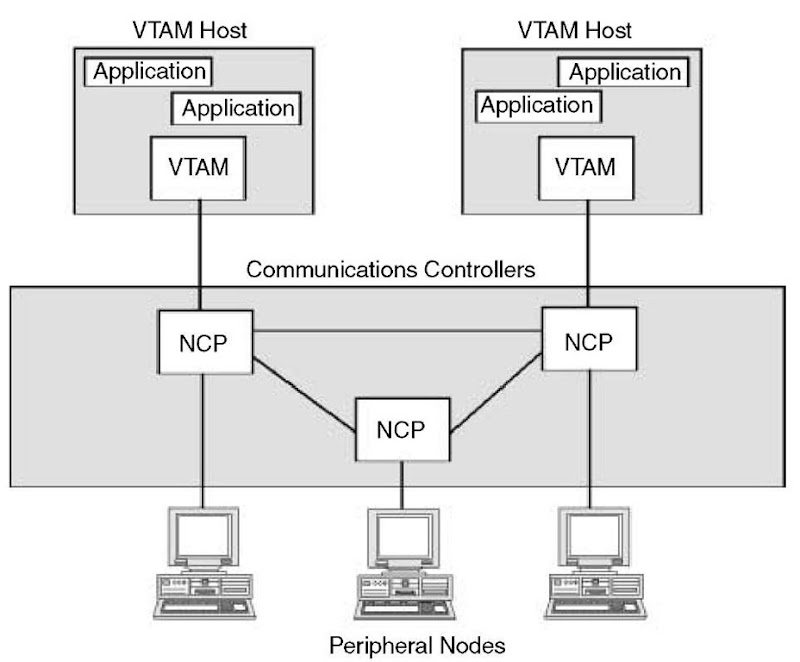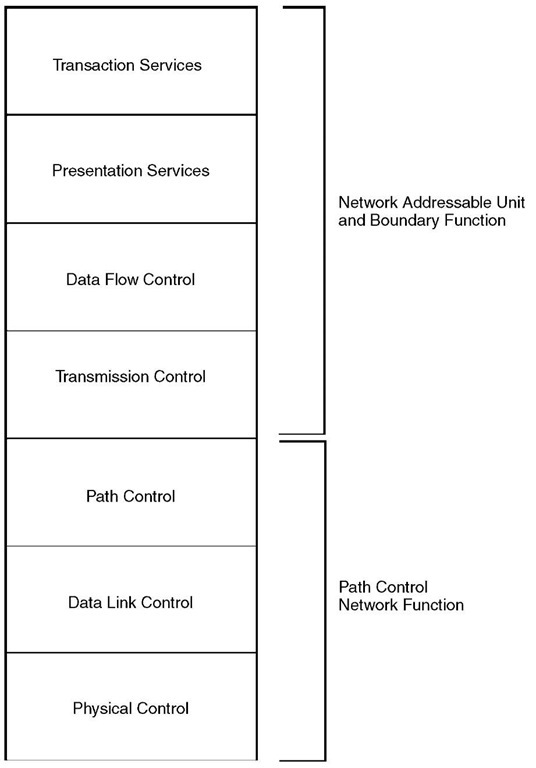Systems Network Architecture (SNA) refers to the protocol used by IBM mainframes. Introduced in 1974, the original hierarchical version of SNA has evolved to support applications in the distributed computing environment and to work with other networking technologies. Legacy SNA networks are hierarchically structured with mainframes at the top of the hierarchy (Figure 112).
IBM’s mainframe-based VTAM (Virtual Telecommunications Access Method) software controls the operation of SNA networks and provides the interface between mainframe-based applications and the network via a communications controller. SNA networks include at least one VTAM host. The backbone of SNA networks is made up of interconnected communications controllers, which have dedicated networking processors that run IBM’s Network Control Program (NCP) software. These controllers route traffic over the campus- and wide-area backbones of SNA networks.
Peripheral Nodes are the terminals, which provide users and applications with access to the SNA network. They can also be PCs equipped with terminal emulation software. In either case, the nodes support only local management functions and do not perform any intermediate routing. Most Peripheral Nodes allow users to communicate only with applications residing on a VTAM host, but they can be allowed to support peer-to-peer communications with users on other Peripheral Nodes.
Functional Layers
The protocols and services defined by SNA are described by a seven-layer model (Figure 113), which is similar in scope to the OSI reference model and is the same layering model defined by the newer version of SNA called Advanced Peer-to-Peer Network (APPN).
Figure 112
Traditional centralized, hierarchical SNA environment.
The lower three layers—Physical Control, Data Link Control, and Path Control—describe the networking services and protocols that provide basic message forwarding in SNA networks. These layers are collectively called the Path Control Network Function.
The Physical Control and Data Link Control layers provide connections between adjacent nodes in an SNA network. The data links are LAN and WAN facilities over which the nodes communicate with each another. The physical and data link layers defined by industry-standard LANs, such as Ethernet, token ring, and FDDI are supported. For wide-area networking, SNA supports physical interface standards such as RS-449 and RS-232. SNA uses Synchronous Data Link Control (SDLC) protocols for communications over dedicated wide area links. SDLC is compatible with the international standard High-level Data Link Control (HDLC) protocol. Industry-standard packet-switching interfaces including X.25, frame relay and ATM are also supported.
SNA also supports IBM’s local channel interfaces for connecting mainframes to local nodes. Parallel bus and tag channel as well as Enterprise Systems Connection (ESCON) technologies are supported by SNA.
Figure 113
The seven-layer SNA protocol model.
SNA requires that its data links provide reliable message delivery. While some other types of networking protocols, such as TCP/IP, can operate over either reliable or unreliable data links, SNA always requires reliable data links. The data link protocols used in SNA networks also require that link-level acknowledgments to polls be received within a fixed time in-terval—usually several seconds. This can present problems when dedicated LAN and WAN data links are replaced by networks that cannot provide fixed transit delays for messages. This situation can occur when SNA data is sent over packet-switching networks or when SNA data is tunneled through TCP/IP internets. (This situation is ameliorated by APPN’s High-Performance Routing protocol discussed below.)
The Path Control layer is responsible for routing messages hop-to-hop across an SNA network. Although Subarea and APPN networks use different addressing and routing techniques, the level of service provided to the upper layers is similar.
Within APPN networks, two different Path Control routing technologies are used. Intermediate Session Routing (ISR) is the original APPN routing protocol and is included in the base set of protocols, which are part of every APPN product. An optional routing protocol, called High performance Routing (HPR), is available for APPN. HPR provides better packet forwarding performance than ISR and adds capabilities such as nondisruptive session rerouting and a flow control protocol that is optimized for operation over high bandwidth data links.
Network Accessible Units
The SNA software components that support end-to-end communications are called Network Accessible Units (NAUs). The top four layers of SNA are implemented within NAUs. The protocols implemented within the four layers are end-to-end protocols that are designed to support communications between a single pair of NAUs. Subarea SNA networks have three types of NAUs:
LOGICAL UNITS (LUs) Software that resides in the various devices that make up an SNA network, which support end-user communications
SYSTEM SERVICES CONTROL POINTS (SSCPs) Central control points of SNA networks, which provide network management and user interconnection functions
PHYSICAL UNITS (PUs) Represent the actual devices on the network, which are managed by SSCPs
Architecture
Each type of node has an architectural designation in addition to its commonly used name. VTAM Hosts are called Type 5 Nodes, Communications Controllers are Type 4 Nodes, and Peripheral Nodes are designated as either Type 2.0 or Type 2.1 Nodes. Type 2.0 nodes support only hierarchical communications with mainframe-based applications, while Type 2.1 Nodes also support peer-to-peer communications. The SNA node types are also commonly called PU Types—an older designation.
Logical Units represent the end users of SNA networks. Examples of end users include applications running on VTAM Hosts or Peripheral Nodes, or the displays and printers used by interactive terminal users. End users communicate with one another via LU-to-LU sessions.
SNA defines several categories of LUs, called logical unit types. Each LU type defines a subset of end-to-end SNA protocols that are used to support communications between a specific category of end users. Among the more commonly used LU types are:
LU TYPE 0 Supports industry-specific terminals used in the financial and retail industries
LU TYPE 1 Supports communications with character-oriented printers
LU TYPE 2 Supports communications with interactive 3270 display stations
LU TYPE 3 Supports communications with 3270 printers
LU TYPE 6.2 Current SNA program-to-program communications protocols, also called Advanced Program-to-Program Communications (APPC) System Services Control Points and Physical Units support network management functions. SSCPs are part of VTAM and always reside on SNA Hosts. SSCPs operating under the control of host-based management software, usually IBM’s NetView, manage all of the resources of an SNA network.
Each of the managed nodes in an SNA network contains a PU, which is responsible for the management of resources of their local nodes and they are controlled by an SSCP. SSCPs and PUs interact over SSCP-PU sessions.
Some types of LUs, called SSCP-dependent LUs, enter into sessions with their SSCPs. These SSCP-LU sessions are used to activate and deactivate LU-LU sessions between dependent LUs. Other types of LUs, called SSCP-independent LUs, can start and stop LU-LU sessions without the intervention of an SSCP. LU Type 6.2 is the only LU type that can function independently.
Users access SNA networks primarily through 3270 terminals or systems providing 3270 emulation. When users initiate an LU-LU session they can specify the class of service (CoS) required for optimal applications performance. CoS defines the required route characteristics including bandwidth, security, and availability needed to satisfy the user’s performance requirements.
APPN
APPN is the latest generation SNA technology for linking devices without requiring the use of a mainframe. Specifically, it is IBM’s proprietary SNA routing scheme for client/server computing in multiprotocol environments. As such, it is part of IBM’s LU 6.2 architecture (i.e., APPC), which facilitates communications between programs running on different platforms.
APPN routes SNA traffic natively across PC LANs. Large IBM shops that must prioritize and route traffic in a peer-to-peer fashion are good candidates for APPN. HPR, used exclusively in the SNA environment, enhances SNA routing and adds to APPN by further prioritizing and routing SNA traffic around failed or congested links. It is used in situations where bandwidth is critical, especially in packet-switched networks.
Included in the APPN architecture are Automatic Network Routing (ANR) and Rapid Transport Protocol (RTP) features. These features route data around network failures and provide performance advantages, closing the gap with TCP/IP. ANR provides end-to-end routing over APPN networks, eliminating the intermediate routing functions of early APPN implementations, while RTP provides flow control and error recovery. To these features, HPR adds a very advanced feature called Adaptive Rate Based (ARB) congestion prevention.
ARB uses three inputs to determine the sending rate for data. As data is sent into the network, the rate at which it is sent is monitored. At the destination node, that rate is also monitored and reported back to the originating node. The third input is the allowed sending rate. Together, these inputs determine the optimal throughput rate, which minimizes the potential for packet discards to alleviate congestion.
By enabling peer-to-peer communications among all network devices, APPN helps SNA users connect to LAN networks and more effectively create and use client-server applications. APPN supports multiple protocols, including TCP/IP, and allows applications to be independent of the transport protocols that deliver them.
APPN’s other benefits include allowing information routing without a host, tracking network topology, and simplifying network configuration and changes. For users still supporting 3270 applications, APPN can address dependent LU protocols as well as the newer LU 6.2 sessions, which protects a company’s investment in applications relying on older LU protocols.
Last Word
The original, hierarchical nature of SNA networking, called subarea SNA, is still widely used to support large-scale, mission-critical applications, such as credit card authorization systems, automatic teller machine networks, and airline reservation systems. However, in response to the networking requirements of new decentralized applications, IBM came up with Advanced Peer-to-Peer Networking, a decentralized, mainframe-independent version of SNA.


